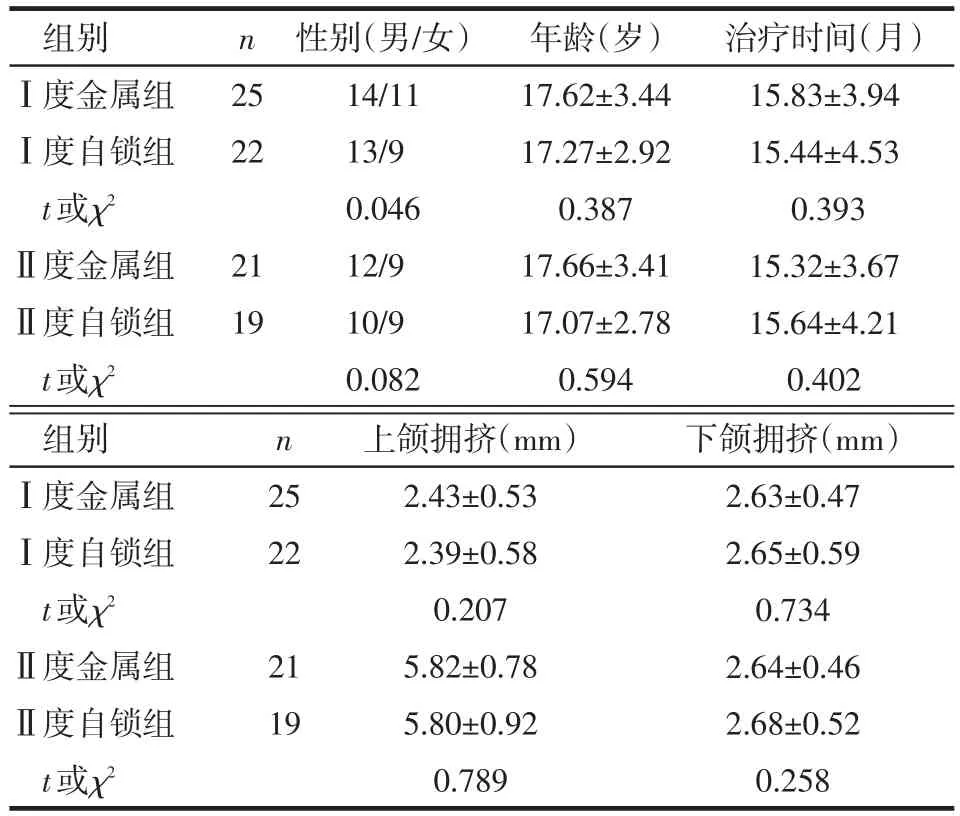自锁托槽和传统托槽非拔牙矫治上颌轻中度拥挤软硬组织及牙弓变化的研究
2014-06-15刘东妮肖丹娜李琴琴
刘东妮 高 辉 肖丹娜 李琴琴
自锁托槽和传统托槽非拔牙矫治上颌轻中度拥挤软硬组织及牙弓变化的研究
刘东妮1高 辉2△肖丹娜2李琴琴3
目的 比较Damon Q自锁和3M金属托槽非拔牙矫治轻中度上颌拥挤软硬组织及牙弓变化的研究。方法选择正畸矫治患者87例,以上颌拥挤程度和采用的矫治器种类分为Ⅰ度、Ⅱ度拥挤Damon Q自锁托槽组(41例),Ⅰ度、Ⅱ度拥挤3M金属托槽组(46例)。测量治疗前后头颅侧位片及模型,整理数据采用配对t检验和成组t检验分析。结果非拔牙矫治上颌Ⅰ度、Ⅱ度拥挤时,两种托槽治疗后上颌牙弓宽度和牙弓长度均有增大,但2组间变化量差异无统计学意义。上颌Ⅱ度拥挤时,比较2组软组织测量项目鼻唇角、上唇倾角、上下唇倾角数值减少,且自锁托槽组变化量大于金属托槽组。结论非拔牙矫治上颌轻中度拥挤时,随拥挤度增大,Damon Q自锁托槽对于软组织上唇突度的改变较3M金属托槽略大,在临床应用中要重视托槽及治疗体系的选择。
正畸学,矫正;拔牙;正畸金属丝;正畸托架;牙弓;非拔牙矫治;头影测量;牙弓宽度;牙弓长度;软硬组织
1 对象与方法
1.1 研究对象 选取2010年9月—2013年11月在天津市口腔医院正畸科矫治患者87例。纳入标准:(1)年龄女性15~30岁,男性16~31岁。(2)骨性Ⅰ类、安氏Ⅰ类,ANB角0°~5°,无前突主诉。(3)上颌牙列存在Ⅰ度或Ⅱ度拥挤,下颌Ⅰ度拥挤,排除前牙区牙性反病例(Ⅰ度0~4 mm,Ⅱ度4~8 mm)。(4)上、下颌牙列完整,除第三磨牙外无缺失牙、畸形牙、多生牙。(5)治疗过程中未使用口外弓、种植钉支抗、扩弓器等辅助装置,未使用功能矫治器,未进行过邻面去釉。(6)无唇腭裂病史及正畸、正颌治疗史。(7)治疗前后影像学资料齐全,治疗前后记存模型完整。
1.2 研究方法
1.2.1 分组 选取的87例样本中,41例采用Damon Q自锁托槽(Ormco公司,美国),46例使用传统金属托槽(3M金属,美国)。按照上颌拥挤度和采用矫治器的种类分为4组:Ⅰ度自锁组22例、Ⅱ度自锁组19例、Ⅰ度金属组25例、Ⅱ度金属组21例。上颌与下颌Ⅰ度、Ⅱ度拥挤时,2组基本情况差异无统计学意义(P>0.05),见表1。

Table 1 The general information of the Damon Q selfligating bracket and 3M metal bracket groups表1 Damon Q自锁托槽组和3M金属托槽组基本情况
1.2.2 治疗方法 自锁组均采用自锁托槽矫治技术及Damon含铜镍钛丝,弓丝使用顺序为0.013/0.014CoNiTi,0.014× 0.025/0.016×0.025CoNiTi,0.018×0.025SS。金属组均采用直丝弓矫治技术,使用国产弓丝(新亚,杭州),使用顺序为0.014NiTi,0.016×0.022NiTi,0.018×0.025NiTi,0.018×0.025SS。
1.2.3 测量方法 铜丝法测量样本拥挤度,采用Wincep 8.0测量软件及电子显示游标卡尺(精确度0.01 mm)完成治疗前后头颅侧位片和模型上颌各段牙弓宽度的测量。测量矫治前后上颌左右尖牙牙尖间距离(WU3)、第一前磨中央窝间距离(WU4)、第二前磨牙中央窝间距离(WU5)和第一磨牙中央窝间的距离(WU6),上颌牙弓长度即上颌中切牙近中接触点至上颌第二磨牙远中接触点间连线的垂直距离。
1.2.4 质量控制 随机抽取40例于首次测量2周后按上述测量方法再次测量模型和头颅侧位片。2次测量结果无明显差异。
1.3 统计学方法 所有数据均采用SPSS 19.0统计软件进行处理。不符合正态分布的通过Box-cox转换。组内治疗前后测量值进行配对t检验,组间治疗前后变化量进行成组t检验,检验前均进行方差齐性验证,如方差不齐采用t′检验。以P<0.05为差异有统计学意义。
2 结果
2.1 治疗前后上颌牙弓变化比较 上颌Ⅰ度、Ⅱ度拥挤时2组矫治后各段牙弓宽度、上牙弓长度均有增加(P<0.01),但2组间矫治前后比较差异均无统计学意义,见表2、3。
2.2 治疗前后骨组织变化比较 2种托槽治疗前后骨组织变化差异无统计学意义,见表4。
2.3 治疗前后牙和牙槽组织变化比较 上颌牙列Ⅰ度拥挤时两种托槽非拔牙矫治后牙和牙上前牙唇倾度均有增加。上颌牙列Ⅱ度拥挤时,发现自锁组上切牙唇倾度变化较金属组有增大趋势,但差异无统计学意义,见表5。
2.4 治疗前后软组织变化比较 上颌牙列Ⅰ度拥挤时2种托槽各测量项目变化量无统计学意义,上颌牙列Ⅱ度拥挤时,2组鼻唇角、上唇倾角、上下唇倾角减少有统计学意义,且自锁组变化量大于金属组,见表6。
3 讨论
3.1 研究样本的选择 本研究选取的样本均为骨性Ⅰ类(0°<ANB<5°)、安氏Ⅰ类,排除骨性Ⅱ、Ⅲ类代偿[4-5]对软硬组织变化的影响。目前研究表明牙弓宽度在男性14岁,女性13岁以后趋于稳定[6]。本研究的样本,女性年龄15~30岁,男性年龄16~31岁,排除生长发育对牙弓宽度研究的影响。为避免下颌Ⅱ度拥挤、前牙反对本研究的干扰,因此纳入
Table 2 Comparison changes of dental arch inⅠcrowding degree maxillary dentition before and after non-extraction treatment in both groups表2 上颌Ⅰ度拥挤2组治疗前后牙弓变化比较 (mm±s)

Table 2 Comparison changes of dental arch inⅠcrowding degree maxillary dentition before and after non-extraction treatment in both groups表2 上颌Ⅰ度拥挤2组治疗前后牙弓变化比较 (mm±s)
*P<0.05,**P<0.01;t1为组间比较,t2为治疗前后配对t检验;表3同
组别金属组自锁组n WU3WU4WU5 t2矫治后37.42±1.13 37.54±1.03 0.746 t2 t2 25 22 20.037**19.426**20.956**17.645**26.347**23.119**t1矫治前35.48±1.08 35.25±1.13 0.513矫治前36.45±1.03 36.34±1.02 0.383矫治后38.31±0.96 38.65±1.10 1.159矫治前42.13±1.06 42.16±1.19 0.351矫治后44.37±1.05 44.29±1.16 0.164组别金属组自锁组n WU6牙弓长度t2 25 22 24.770**21.700**t2 21.162**23.218**t1矫治前47.13±1.04 47.19±0.91 0.263矫治后48.34±1.08 48.59±0.92 0.959矫治前45.47±0.92 45.13±0.98 1.045矫治后47.84±0.83 47.59±0.92 0.928
Table 3 Comparison changes of dental arch inⅡcrowding degree maxillary dentition before and after non-extraction treatment in both groups表3 上颌Ⅱ度拥挤2组治疗前后牙弓变化比较 (mm±s)

Table 3 Comparison changes of dental arch inⅡcrowding degree maxillary dentition before and after non-extraction treatment in both groups表3 上颌Ⅱ度拥挤2组治疗前后牙弓变化比较 (mm±s)
组别金属组自锁组t1 n WU3WU4WU5 t2 t2矫治前35.28±0.88 35.21±1.01 0.523矫治后37.21±1.04 37.43±1.11 0.459 t2 21 19 24.729**47.035**矫治前36.11±1.01 36.28±0.91 0.253矫治后37.92±0.89 38.61±1.04 0.767 31.479**33.253**矫治前42.27±0.91 42.25±0.74 0.348矫治后44.52±0.89 44.36±0.76 0.879 49.529**50.889**组别金属组自锁组n WU6牙弓长度t2 21 19 28.442**23.126**t2 24.863**26.693**t1矫治前47.06±0.75 47.15±0.73 0.586矫治后48.38±0.62 48.61±0.63 1.175矫治前45.30±0.58 45.13±0.42 1.270矫治后48.85±0.57 49.13±0.57 1.401
Table 4 Comparison changes of bone tissue measurements before and after treatment in both type brackets表4 2种托槽矫治前后骨组织测量项目变化比较 (±s)

Table 4 Comparison changes of bone tissue measurements before and after treatment in both type brackets表4 2种托槽矫治前后骨组织测量项目变化比较 (±s)
均P>0.05
组别Ⅰ度金属组Ⅰ度自锁组tⅡ度金属组Ⅱ度自锁组t组别Ⅰ度金属组Ⅰ度自锁组tⅡ度金属组Ⅱ度自锁组t n 25 22 21 19治疗后81.12±2.29 81.43±2.67 0.645 82.08±1.41 82.68±1.99 1.078差值-0.19±0.41 -0.28±1.36 0.284 0.57±0.99 0.36±1.10 0.797治疗后77.15±2.58 77.14±3.67 0.242 79.62±1.37 79.56±3.09 0.123差值-0.26±0.45 -0.24±1.45 0.064 0.27±1.34 0.23±1.16 0.020n 25 22 21 19 SNA(°)治疗前81.38±2.25 81.71±2.42 0.691 81.47±1.51 82.38±1.82 1.613 ANB(°)治疗前3.45±1.10 3.62±1.23 0.558 2.25±0.58 2.81±1.23 1.533治疗后3.57±1.16 3.78±1.16 0.733 2.43±0.81 2.70±1.24 0.806差值0.12±0.46 0.16±0.68 0.347 0.18±0.90 -0.11±0.74 1.225 SNB(°)治疗前77.94±2.67 77.98±2.87 0.205 79.33±1.47 79.33±2.42 0.044 MP-FH(°)治疗前29.71±6.03 32.09±5.60 1.213 31.73±5.43 29.59±3.95 1.155治疗前29.82±5.46 33.43±5.96 1.468 31.88±5.63 29.42±4.58 1.223差值0.11±0.33 0.33±0.81 0.693 0.16±1.01 0.17±0.96 0.328
Table 5 Comparison changes of teeth and alveolar tissue after and before treatment with different maxillary crowding degree表5 不同程度上颌拥挤各组牙和牙槽组织矫治前后变化比较 (±s)
均P>0.05
组别Ⅰ度金属组Ⅰ度自锁组t n 25 22 U1-SN(°)2.44±0.93 2.35±0.98 0.513 U1-NP(mm)0.73±0.49 0.79±0.62 1.569 U1-NA(mm)0.88±0.35 1.05±0.58 1.114 U1-NA(°)2.45±1.04 2.28±0.68 0.453 U1-AP(mm)0.97±0.46 1.12±0.90 0.549 L1-MP(°)1.75±0.61 1.48±0.55 1.352 L1-NP(mm)1.56±0.87 1.38±0.91 0.567 L1-NB(mm)1.52±0.75 1.72±1.10 0.705组别Ⅱ度金属组Ⅱ度自锁组t组别Ⅱ度金属组Ⅱ度自锁组t n 21 19 n 21 19 L1-NB(°)4.27±2.53 4.07±1.72 0.202 U1-AP(mm)1.19±0.51 1.39±0.54 1.136 L1-AP(mm)1.28±0.75 1.39±1.19 1.576 L1-MP(°)1.32±0.86 1.38±1.52 0.041 U1-L1(°)-4.95±2.67 -4.56±1.05 0.933 L1-NP(mm)1.67±0.81 1.72±1.28 0.129 U1-SN(°)2.52±1.09 2.77±1.34 0.591 L1-NB(mm)1.56±1.05 1.70±0.92 0.698 U1-NP(mm)1.32±0.76 1.94±1.42 1.709 L1-NB(°)4.19±1.29 4.29±1.23 0.028 U1-NA(mm)1.40±0.83 1.59±1.46 0.457 L1-AP(mm)1.37±0.72 1.65±0.83 1.102 U1-NA(°)3.16±1.54 3.94±1.39 1.458 U1-L1(°)-6.85±2.97 -7.18±2.38 0.256
Table 6 Comparison changes of soft tissue after and before treatment with different maxillary crowding degree表6 不同程度上颌拥挤软组织测量项目矫治前后变化比较 (±s)

Table 6 Comparison changes of soft tissue after and before treatment with different maxillary crowding degree表6 不同程度上颌拥挤软组织测量项目矫治前后变化比较 (±s)
*P<0.05;**P<0.01
组别Ⅰ度金属组Ⅰ度自锁组tⅡ度金属组Ⅱ度自锁组t n 25 22 21 19 Ns-Sn-Pos(°)0.34±1.23 0.51±0.94 0.731 0.63±0.96 0.65±1.01 0.135鼻唇角(°)-0.20±2.44 -0.52±0.88 0.729 -1.67±0.98 -2.49±1.26 2.084*上唇倾角(°)-1.45±0.95 -1.14±0.51 1.486 -2.11±1.52 -3.16±1.43 2.159*下唇倾角(°)-1.51±1.02 -1.46±0.76 0.226 -1.01±0.52 -1.40±0.62 1.231上下唇倾角(°)-1.63±0.82 -1.67±0.71 0.459 -2.65±1.38 -3.81±1.63 2.212*H角(°)0.29±1.70 0.42±1.10 0.487 0.92±1.06 1.48±1.85 1.190组别Ⅰ度金属组Ⅰ度自锁组tⅡ度金属组Ⅱ度自锁组t n 25 22 21 19上唇-E线(mm)1.04±1.37 1.03±0.47 0.034 1.11±0.61 1.59±0.53 0.829下唇-E线(mm)0.16±1.28 0.68±1.56 0.203 0.90±1.26 1.18±1.31 0.935 UL-UI(mm)-0.37±0.64 -0.34±1.36 0.182 -0.92±0.43 -1.08±0.26 1.144 LL-LI(mm)-0.91±0.39 -1.02±0.49 1.020 -1.38±0.71 -1.57±0.68 0.838 Sn-A(mm)-0.73±0.44 -0.82±0.41 0.470 -1.17±0.59 -1.41±0.62 1.074 Pos-Po(mm)-1.11±1.89 -0.82±0.58 1.013 -1.01±2.11 -1.17±1.41 1.014
3.2 颌骨变化 本研究结果显示骨组织治疗前后的变化无统计学意义,说明无论采用何种矫治器,单纯正畸治疗的作用主要是对上、下牙牙轴的改变而对改变颌骨关系的作用不大。这与周昱等[7-8]研究结果相似。
3.3 牙和牙弓宽度、长度变化 本研究中发现上颌Ⅰ度、Ⅱ度拥挤时两种托槽均有一定的扩弓作用,且扩弓作用无差别,与Padhraig等[9-10]研究结果相似。上颌拥挤度越大,治疗后上颌牙弓长度越长,而牙弓宽度变化不明显。陶列等[2]研究发现上颌第二磨牙萌出后,非拔牙矫治中上颌牙弓长度增加主要表现为前牙唇倾。本研究样本的上颌第二磨牙均已萌出,随上颌拥挤度增大,两种托槽主要通过增大上前牙唇倾度来解决拥挤。两组间变化量比较虽然无统计学意义,但随上颌拥挤度增大,自锁组较金属组对上切牙唇倾作用有增大趋势,可能是本研究样本例数有限而未表现出明显统计学意义。
3.4 软组织变化 上颌Ⅰ度拥挤时,两种托槽对软组织的作用没有差异,而上颌Ⅱ度拥挤时两组鼻唇角、上唇倾角、上下唇倾角的变化有统计学意义,且自锁组较金属组对上唇突度变化的影响略大。唇内部由上下切牙支撑,上下切牙唇向移动对唇的位置、形态、厚度以及紧张度会产生较大影响[11-12]。随上颌拥挤度的增大,自锁组较金属组对上切牙的唇倾作用有所增大,可能是导致自锁组治疗后上唇突度改变较金属组大的原因之一。此外,Damon[3]认为自锁托槽可利用唇肌训练获得一定的唇挡作用,有效防止前牙唇倾,以获得较满意的软组织侧貌。本研究结果并未反映出自锁组有利用唇肌功能防止前牙唇倾、改善侧貌的特点。这与其他学者的研究一致,姜若萍等[13]认为应用自锁托槽并不能防止前牙唇倾,对拥挤病例非拔牙矫治时应选择面型较好的病例。关于唇肌功能训练研究较少,加之唇肌训练受患者依从性影响较大,自锁托槽所谓的功能矫治器的作用有待深入研究[3]。因此,在临床应用中对上颌牙列拥挤较大的患者要综合面型、拥挤程度、上唇形态、唇肌紧张度等因素,慎重选择矫治体系及矫治器。由于本研究样本例数有限,对性别和不同部位拥挤矫治前后软硬组织及牙弓变化未进行研究,今后需增大样本深入探讨,以期更好地指导拥挤病例的临床治疗。
[1]周欣荣,盛敏,厉松.自锁托槽不拔牙矫治牙弓形态变化的研究[J].中华口腔正畸学杂志,2009,16(2):90-94.
[2]陶列,姚冉,唐国华,等.应用Damon技术矫治上颌牙列拥挤的牙弓测量分析[J].上海口腔医学,2008,17(3):243-249.
[3]Damon D.Introducing the Damon systemⅡ[J].ClinImpressions, 1999,8(2):2-9.
[4]刘颖,肖丹娜,孙留振,等.骨性Ⅲ类错牙弓、基骨弓宽度及协调性分析[J].中华口腔正畸学杂志,2013,20(2):81-84.
[5]范向飞,高辉,肖丹娜,等.骨性Ⅱ、Ⅲ类错患者前牙弓形态特点分析[J].山东医药,2011,51(11):81-82.
[6]Ross-Powell RE,Harris EF.Growth of the anterior dental arch in bleak American Children:A longitudinal study from 3 to18 years of age[J].Am J Orthod Dentofacial OrthoP,2000,118(6):649-657.
[7]周昱,郑敏玲,胡荣党.自锁托槽与传统托槽不拔牙矫治软硬组织及牙弓变化的对比研究[J].口腔医学,2012,3(32):154-157.
[8]林燕,赵弘,张英,等.应用直丝弓矫治器对双牙弓前突进行拔牙矫治前后颌面软硬组织的变化[J].口腔正畸学,2002,1(9):20-21.
[9]Padhraig S,Robert T,Marinho V,et al.Comparison of maxillary arch dimensional changes with passive and active self-ligation and conventional brackets in the permanent dentition:A multicenter, randomized controlled trial[J].Am J Orthod Dentofacial Orthop, 2013,144(2):85-93.
[10]乔仙,丁寅,鱼敏,等.自锁托槽与传统金属托槽扩弓效果的对比研究[J].口腔医学研究,2011,28(4):572-574.
[11]Hayashida H,Ioi H,Nakata S,et al.Effects of retraction of anterior teeth and initial soft tissue variables on lip changes in Japanese adults[J].Eur J Orthod,2011,33(4):419-426.
[12]Konstantonis D.The impact of extraction vs nonextraction treatment on soft tissue changes in Class I borderline malocclusions[J].The Angle Orthodontist,2012,82(2):209-217.
[13]姜若萍,傅民魁.自锁托槽非拔牙矫治下牙列拥挤的临床研究[J].中华口腔医学杂志,2008,43(8):459-463.
(2014-01-23收稿 2014-03-16修回)
(本文编辑 魏杰)
Changes in Dental Arch and Hard and Soft Tissue Caused by the Self-Ligating Bracket and Conventional Bracket with Non-Extraction Treatment in Maxillary Mild-to-Moderate Crowding Cases
LIU Dongni1,GAO Hui2,XIAO Danna2,LI Qinqin3
1 Tianjin Medical University,Tianjin 300070,China;2 Tianjin Stomatological Hospital;3 Shanxi College of Traditional Chinese Medicine Affiliated Hospital
ObjectiveTo compare changes in dental arch and soft and hard tissue produced by the Damon Q selfligating bracket and 3M metal bracket with non-extraction treatment in maxillary mild-to-moderate crowding cases.Meth⁃odsEighty seven patients were selected in our study,who were assigned to 4 groups by the crowding degree of maxillary and appliance type:ⅠandⅡcrowding degree using Damon Q self-ligating bracket groups(41 cases);ⅠandⅡcrowding degree 3M metal bracket groups(46 cases).We measured lateral cephalometric radiographs and dental casts at both beginning and end of treatment.Paired t-tests and group t-tests were used in statistical analysis to compare the alteration in dental arch and soft and hard tissue.ResultsThere was significant increase in width and length of maxillary dental arch by nonextraction treatment withⅠandⅡcrowding degree maxillary,but the results of both groups were not of statistical difference. To compare hard and soft tissue in two groups withⅡcrowding degree maxillary,the reduction of nasolabial angle,angle of inclination of upper lip,angle of upper lip and lower lip had obvious statistical significance and it is more prominent in selfligating bracket group than in conventional bracket group.ConclusionUsing non-extraction treatment,when maxillary crowding is moderate,,Damon Q self-ligation bracket group result in more prominent changes of upper lip protrusion than 3M bracket with more marked crowding.Therefore,clinical doctors should pay more attention to choose bracket and treatment system for patients with marked crowding of maxillary dentition.
orthodontics,corrective;tooth extraction;orthodontic wires;orthodontic brackets;dental arch;non-extraction treatment;cephalometric;arch width;arch length;hard and soft tissue
R783.5
B
10.3969/j.issn.0253-9896.2014.06.027
1天津医科大学研究生院(邮编300070);2天津市口腔医院正畸科;3山西中医学院附属医院口腔科
△通讯作者 E-mail:keyanjiaoxue@gmail.com
